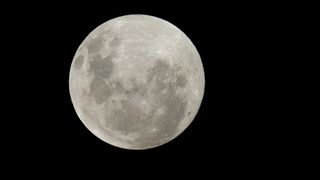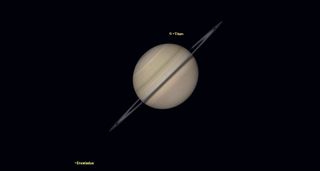May full moon 2024: The Flower Moon crosses the Scorpion's Heart
The Full Flower Moon of May 2024 will see the moon pass in front of the red star Antares, the brightest star in Scorpius, the Scorpion.

The Full Flower Moon of May 2024 rises on May 23.
The official moment when the full moon reaches 100% fullness will occur on May 23 at 9:53 a.m. Eastern Daylight Time (1353 UTC), according to the U.S. Naval Observatory. Observers in the southeastern U.S., Central America, northeastern South America, the Caribbean, and parts of the western coast of Africa, will see the full moon will also pass in front of the red star Antares, (Alpha Scorpii) the brightest star in Scorpius, the Scorpion.
A full moon happens when the moon is opposite the sun with Earth in between. Earthbound observers see a fully-illuminated moon (unless they are on the daylight side of the Earth).
Related: Full moon calendar 2024: When to see the next full moon

Looking for a telescope to see the moon? We recommend the Celestron Astro Fi 102 as the top pick in our best beginner's telescope guide.
Observers in New York City will see moonrise at about 8:52 p.m. local time on May 23. The sun sets at 8:14 p.m. on that day. The moon will pass in front of – or occult – the red star Antares later that night but the event won't be visible from New York; instead observers there will see a very close pass of the moon just to the south of Antares (a bit more towards the horizon).
Full moons are reckoned relative to the position of the moon and Earth; one's location on Earth doesn't matter except to check what the local time is – while the moon turns full at 9:53 a.m. a London-based sky watcher would see it happen at 1:53 p.m. the same afternoon, and a Japanese observer would see it happen at 10:53 p.m.
While New Yorkers will only see a close pass to Antares, skywatchers in cities such as Charleston, South Carolina, Savannah, Georgia, and Miami will see the moon pass in front of Antares. In Charleston, Antares will disappear behind the illuminated side of the moon at 9:09 p.m. Eastern and reappear from behind it at 10:15 p.m. In Savannah, Antares will disappear at 9:17 p.m. and reappear at 10:16 p.m.; in Miami it will be at 9:12 p.m. and 10:18 p.m.
In Belem, Brazil, near the far northeast of South America, the occultation starts at 11:02 p.m. local time and ends at 12:39 a.m. May 24. Crossing the Atlantic one sees that in Lagos, Nigeria, the occultation will start at 4:15 a.m. local time and end at 5:23 a.m.
Unlike lunar phases, spotting occultations is affected by one's location. In the case of occultations by the moon, the issue is that the moon is close enough that moving from one part of the Earth's surface to another can significantly alter the moon's apparent position against the background stars. That is why the moon only makes a really close approach to Antares if one is watching from New York, and is a short distance away if one watches from Boston, but other locales will be able to see the moon occult the star.

You can prepare for the next full moon or eclipse with our guide on how to photograph a lunar eclipse, as well as how to photograph the moon with a camera in general, can help you make the most of the event. If you need imaging gear, consider our best cameras for astrophotography and best lenses for astrophotography to make sure you're ready for the next eclipse.
If you're looking for binoculars or a telescope to observe the moon, check out our guides for the best binoculars and best telescopes.
Related: The ultimate guide to observing the moon
Visible planets
Besides getting to see the moon occult Antares, there will also be some planets accompanying our satellite in the sky. Mercury, Venus and Jupiter will be largely lost in the sunlight for people in mid-northern latitudes. However in the predawn sky one will see Saturn and Mars, which rise in that order; from New York City on May 24 Saturn rises at 2:25 a.m. local time, and Mars at 3:31 a.m.
Saturn will be in the constellation Aquarius, and stand out among the constellation's fainter stars, while Mars will be in Pisces, another faint constellation which will make Mars more visible by comparison. By about 4:30 a.m. Saturn will be 21 degrees high in the southeast and Mars to the left of Saturn, almost due east at an altitude of about 10 degrees. In New York, sunrise is at 5:31 a.m. local time; it will be similar in other mid-northern latitude areas.

For those watching the sky from south of the Equator, Saturn and Mars will appear higher and for a longer as late May is most of the way through the Southern Hemisphere autumn; the winter solstice there is in June. Mercury also will be high enough to observe. That means nights are getting longer and the sun rises later; in Melbourne, Australia sunrise is not until 7:20 a.m. and on May 24 Saturn will be 58 degrees high in the northeast at that point; the planet rises at 1:09 a.m.
Mars follows at 3:34 a.m. and Mercury rises at 5:29 a.m. Mars will be 38 degrees high at sunrise and Mercury at 19 degrees – the three planets will form a rough line running from north to east.
Constellations
Among stars, by 9 p.m. in the mid-northern latitudes, Vega (made famous by the movie "Contact" as the home of the aliens who communicate with Earth) will be rising in the northeast, marking one of the corners of the Summer Triangle, an asterism marked by Vega, Deneb and Altair. Vega, being in the east and one of the brighter stars, will be one of the first to become visible as the sky darkens.
Turning to the left of Vega – northwards – one will see the Big Dipper; if one faces due north the Dipper will be to the left, slightly west of north, and appear to be almost upside down.
One can use the handle of the Big Dipper to "Arc to Arcturus", the brightest star in Boōtes, the Herdsman. Arcturus is recognizable because it looks slightly reddish or orange. If one draws a line between Vega and Arcturus, the line crosses two constellations: closer to Boötes is Corona Borealis, the Northern Crown, and as one moves towards Vega one encounters a group of four medium-bright stars in a square, which is the "keystone" – the center of the constellation Hercules.
If one continues the "arc" from Arcturus one ends up reaching Spica, the alpha star of Virgo, and turning to the right (towards the south) and looking higher in the sky one sees Leo, the Lion.

In the mid-southern latitudes, the sky will be dark by 7 p.m. and one will see the moon rising close to Antares in the east (if one isn't in the zone where the occultation is visible). Looking north (to the left) one will see Arcturus rising, and Spica above and to the right of it – Spica will be about halfway to the zenith. If one turns southwards (to the right) one can spot two bright stars that are close together at about the same altitude as Spica; the upper one is Hadar and the lower is Rigil Kentaurus, or Alpha Centauri. If one draws a line between the two and goes upwards, one hits the Southern Cross.
Turning further to the right, towards the west, one will spot a bright star (again about halfway to the zenith). This is Canopus, or Alpha Carinae, the brightest star in the Keel, one of the three constellations that makes up Argo, the legendary ship of Jason. Once, Argo was a single large constellation; but more modern astronomers have divided it into three: Carina the Keel, Puppis the Poop Deck, and Vela the Sail. The latter can be seen as a large ring or ellipse of medium-bright stars above Canopus, while Puppis is to the right of Canopus.
Full moon lore
The full moon of May is often called a Flower moon, and the term comes from the blooms that appear in North America around that time; many Algonquin-speaking peoples in the northeastern part of the continent called it something similar, such as the Ojibwe, according to the Ontario Native Literacy Coalition. The Cree called it the Frog moon, as May is when frogs tend to become active. Both Anishinaabe and Cree traditions reflect the environment in northeastern North America, where the two peoples live.
In other parts of the Americas different peoples had their own traditions -- the Haida, for example, would have called the May moon cycle Tahálaa Kungáay, the Food Gathering moon. Among the Cherokee, the "Flower moon" actually corresponded with April; May would be called the "Planting moon."
In the Chinese lunar calendar the May full moon is in the fourth month, called Huáiyuè, the Locust Tree Month.
In the Southern Hemisphere, the Māori described the lunar month of Pipiri, which occurs from May to June: "all things on earth are contracted because of the cold," according to the Encyclopedia of New Zealand. In South Africa, the Zulu used a lunar calendar and called the May lunation uNhlaba, after the aloe plants that bloom at that time of year.
Editor's Note: If you snap an image of the full Flower Moon and would like to share it with Space.com's readers, send your photo(s), comments, and your name and location to spacephotos@space.com.
Follow us on Twitter @Spacedotcom and on Facebook.
Join our Space Forums to keep talking space on the latest missions, night sky and more! And if you have a news tip, correction or comment, let us know at: community@space.com.
Get the Space.com Newsletter
Breaking space news, the latest updates on rocket launches, skywatching events and more!

Jesse Emspak is a freelance journalist who has contributed to several publications, including Space.com, Scientific American, New Scientist, Smithsonian.com and Undark. He focuses on physics and cool technologies but has been known to write about the odder stories of human health and science as it relates to culture. Jesse has a Master of Arts from the University of California, Berkeley School of Journalism, and a Bachelor of Arts from the University of Rochester. Jesse spent years covering finance and cut his teeth at local newspapers, working local politics and police beats. Jesse likes to stay active and holds a fourth degree black belt in Karate, which just means he now knows how much he has to learn and the importance of good teaching.
